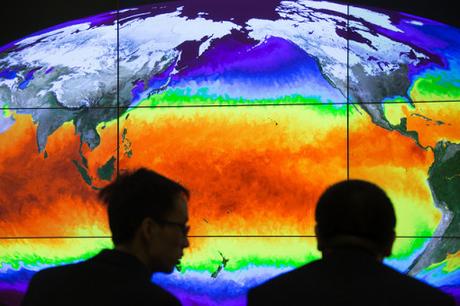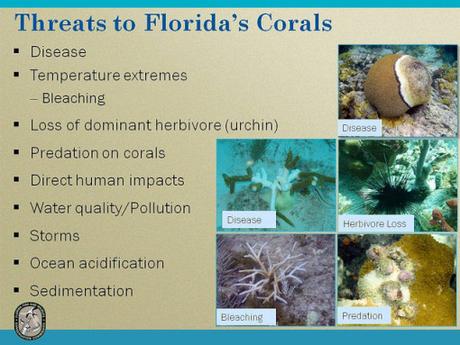If you pay attention to the climate talks, you have probably heard concern expressed over the rising rates of ocean acidification. In a nutshell, this means that the pH levels within the ocean are becoming more acidic. This has happened before in the Earth’s history but it didn’t affect mankind as they weren’t in existence. Now, ocean acidification holds the potential for impacting the human race in a great way.
According to Wikipedia,
Ocean acidification is the ongoing decrease in the pH of the Earth’s oceans, caused by the uptake of carbon dioxide (CO2) from the atmosphere. An estimated 30–40% of the carbon dioxide released by humans into the atmosphere dissolves into oceans, rivers and lakes.

Ocean acidification – the excess carbon dioxide in the atmosphere that is turning the oceans increasingly acid – is a slow but accelerating impact with consequences that will greatly overshadow all the oil spills put together. The warming trend that is CO2-related will overshadow all the oil spills that have ever occurred put together.
– Sylvia Earle
Ocean acidification or “OA” for short is caused by an increase of carbon dioxide in the water. This then increases the acid pH of the water and prohibits calcification. The reason this is so detrimental is that too much carbon dioxide has the effect of blocking photosynthesis. Many people don’t think about photosynthesis when it comes to the ocean but light penetrates the ocean and affects all forms of marine and plant life within the ecosystem. If light is blocked, certain species begin to die out. Ocean acidification affects bottom dwelling organisms, algae and coral mostly. That in turn has a chain reaction effect that in the end affects ground dwelling life.
Earth’s oceans have maintained stable acidity levels over last tens of millions of years. It’s within this environment that flora and fauna has risen and flourished. Over the last 100 years, there has been unprecedented increase in the number of fossil fuel powered vehicles, industries and power plants. The unfortunate consequence, however, has been the emission of billions of tons of CO2 into the atmosphere. Due to the emission of billions of tons of carbon dioxide (CO2) and other greenhouse gases into the Earth’s atmosphere, the ocean has absorbed some 525 billion tons of CO2.
The oceans currently absorb at-least quarter of the CO2 that gets generated by burning fossil fuels. It is estimated that oceans absorb CO2 approximately 22 million tons per day. As 70% of the earth’s surface is covered with water, enough CO2 can have a major impact. The absorption of high amount of CO2 per day has resulted in dropping of pH in surface waters.
Initially, it appeared to scientists that it is helping the environment as it leaves less CO2 in the atmosphere as more of it could have caused catastrophic effects on the climate. But, in the last decade scientists realized that when CO2 get dissolved in the ocean, the water becomes more acidic and the ocean’s pH drops. pH is a measure of how acidic or basic the ocean is. The introduction of large amount of CO2 into the ocean is affecting the life cycle of many marine plants and animals and altering the water cycle.
Over the last 300 million years, the ocean had a pH of approximately 8.2. But, since the beginning of the industrial revolution in the early 1800s, the pH of the ocean has dropped by 0.1 unit. Scientists estimate that if CO2 emissions continue at an existing rate, it could reduce ocean pH by another 0.5 units.
How Acidification Causes Decrease in Calcification?
Acidification leads to a decrease in calcification. This affects just about every life form in the ocean. Calcification is a result of the promotion of calcium carbonate. Too much acid and that production is limited. This is bad news for marine life who depend on the calcification process to form shells and plates. Calcium carbonate minerals are required by many marine organisms as they are building blocks for their shells and skeletons. If the pH level is too high, growth for other marine organisms is limited as they cannot make larger shells to grow into. Coral growth is also inhibited, and there is also more coral bleaching – this reduces the available habitats for marine life too.
The last time that the Earth experienced a notable rise in ocean acidification was over 56 million years ago. It is considered to be the calling card of the Paleocene-Eocene Thermal Maximum era. You don’t read much about that in science classes as its impact was primarily on the ocean’s bottom and ecology located there. During this time the bottom dwellers of the ocean all but died out and it is thought that many of our major coral structures also bleached and created a foundation for the coral reefs and underwater structures we explore today.
If you were to compare what happened in the Paleocene-Eocene Thermal Maximum period with what is happening today the rate is almost 65% higher. This isn’t just that the ocean acidification is occurring at a higher rate, but that it is also occurring at a much faster rate. Scientists can also see the effects more clearly because of the speed at which the pH levels are changing. Many species are already dying out, coral is bleaching and the level or depth of photosynthesis within the ocean is slowing. There is also a higher presence of calcification within the oceans ecosystem with plants and marine life.
Impact of Ocean Acidification
Not all of the impact of ocean acidification is bad. It depends on whose benefit you are assessing when you consider the issue. Some species of marine life thrive in waters with higher pH levels. For man, and other marine life – the effects can be devastating.
- Positive – Some marine life forms, such as Sea Stars, thrive under higher pH. Their numbers can increase as their habitat increases in the marine world. If the animals don’t rely heavily on a food chain supported by deep photosynthesis, or are prey to animals that do – their population grows.
- Negative – Ocean acidification presents the potential for devastating effects to the world’s fishing industries. Not only does the increase in coral bleaching lead to a loss of protective barriers for fishing areas, but the food chain for many fished species is destroyed. That will lead to a loss in fishing production and the potential end of ocean fishing. The fact that the coral bleaches also holds the potential for putting seaside towns and cities at risk. Coral forms the barrier that changes the currents of the water and prevents many storms from reaching land. If the coral ceases to grow it will begin to erode and that will change coastal weather patterns and ocean impact ratings.
What causes Ocean Calcification?
The two main causes of ocean calcification are natural environmental cycles, and man-made pollution.
- Natural Causes – That the pH levels in the ocean have changed before is documented, but scientists do not know why this happened. It may be a part of the natural decay cycle of the Earth’s ecosystem.
- Man-made Causes – What scientist do know is that the radical increase in carbon emissions from human society have sped the rise the pH levels in the ocean. Carbon emissions get absorbed into the water and overwhelmed its natural processing of carbon dioxide. This increases carbon dioxide levels in the water, creates acidification and decreases calcification.

Solutions For Ocean Acidification
There are two very different solutions being used to combat ocean acidification. The effectiveness of these solutions remains to be seen but in an unusually proactive venture, both are being put into place while more discussion is being had on a global level.
- Limit Man-made Carbon Emissions – This is the center-point of almost all of the climate talks. Governments are capping carbon emission allowances for industries as part of the effort to reduce its impact on ecosystems. There have been several set-backs to these policies but many industries are finding them to be popular with customers so are adopting them.
- Iron Fertilization – By proactively seeding the ocean with iron, scientists hope to create a way to absorb excess carbon dioxide so the ocean’s systems don’t have to attempt to process it. While this has a good chance of slowing or controlling ocean acidification the long term effects on the ecosystem are still not known.
Ocean Acidification: A Global Problem
In the end, the real result of the scientific analysis of the trend of ocean acidification is to underscore the need for climate engineering becoming a priority. It may not be feasible to limit carbon emissions given the fast growth rate of manufacturing and human population. The more people live on earth the more carbon emissions rise – not just from consumption, but the very act of living too. It may be more realistic to invest in climate engineering proposals, such as iron fertilization, as solutions. Over the last decade, there has been much interest shown by the scientists in studying the impact of ocean acidification. Since the study started little late, it is impossible to predict as to how ocean acidification will impact marine life and what will be its consequences on the Earth’s ecosystem.
Scientists and environmental advocates are using education as a way to engage public interest in solving the problem of ocean acidification. Just telling them that fish they like to eat may become more expensive, or extinct, is too far away from the day to make an impact. Instead, scientists are recasting the information into how it is beginning to change our daily experience of ocean and marine life. From there they are promoting support for climate engineering efforts. With the world’s population increasing, making sure the ocean is everyone’s priority is the best way to prevent the potential disastrous effects of ocean acidification.
References:
Ocean Portal , ocean acidification

